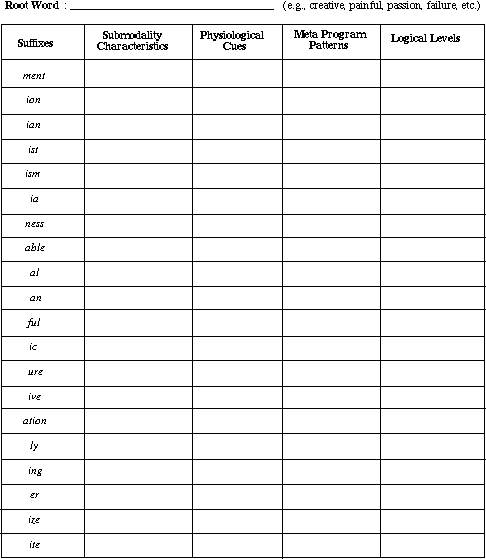The NLP Pattern of the Month:
Exercise: Exploring the Impact of Transderivational Morphology
- Find a negative identity level statement that has a lot of negative "charge," using the following prompts as a guide:
| I am _________________. (angry, tired, confused, frustrated, etc.)
|
|---|
| I am a _________________. (victim, failure, asthmatic, etc.)
|
|---|
| I am not ___________________. (successful, happy, content, etc.)
|
|---|
| I have a lot of ___________________. (pain, discomfort, problems, resistance, blocks, etc.)
|
|---|
| I have no __________________. (vision, creativity, motivation, etc.)
|
|---|
- Identify the key words and begin to play with their "morphology" by shifting or adding prefixes and suffixes. It is especially provocative to try out affixes that do not normally go with the root word.
Take a word like "victim," for example. This root word could be altered in the following ways.
| victim | previctim | victimism
|
|---|
| victist | exvictim | victiment
|
|---|
| victism | unvictim | victimia
|
|---|
| victing | covictim | victimily
|
|---|
| victful | devictim | victimer
|
|---|
Some possible prefixes and suffixes are listed below:
| Suffixes | | | Prefixes
|
|---|
 | | | 
|
|---|
- Notice the shifts that the different affixes make on your experience. You can use the following worksheet to explore and record the impact of the various word structures.
Submodality Characteristics include distinctions such as:
| Movement | Color | Focus | Perspective | Distance | Location | Size
|
|---|
Adding the prefix "un" to fail in order to make "unfail," for instance, may reverse the direction of a particular mental movie. Adding the suffixes "ment" or "ia" to create "failment" and "failia" may shift the image of the reference experience to one that is more disassociated, or shift the feeling response that you have to the word to a different location in your body.
Physiological Cues involve changes in breathing, body symmetry, eye position, posture, etc., that accompany your reaction to the word. You may have a different eye position while considering the term "prefailure" than "refailure" or "metafailure."
Meta Program Patterns relate to distinctions such as:
Chunk Size: larger - smaller
Time Orientation: past - present - future
Point of Reference: self (internal) - other (external) - context (neutral)
Attitude: toward - away
Altering the word "fail" to "cofail," for example, may shift the point of reference from 'self' to 'other' or 'context'. Creating the words "transfailation" and "defailize" may change the 'chunk size' with which one is considering the experience to be either larger or smaller.
Logical Level changes involve the shift in the focus of the reference experience to different 'levels' of experience; i.e., environment, behavior, capabilities, beliefs and values, or identity. A person may originally experience the meaning of "failure" at the level of belief or identity, for instance. Altering the word to "failable" or "failizing" may move the focus of the experience to the level of capability.
Usually, there will combinations of patterns. Shifting the term "failure" to "failist," or "failite" may focus the experience at the identity level but simultaneously make it more disassociated.
Transderivational Morphology Worksheet

References
Contemporary Linguistics; O'Grady, W., Dobrovolsky, M., and Aronoff, M., 1989.
Also see the Article of the Month or the Archives if you are interested in checking out NLP in more depth.
For information on Robert Dilts’ products and services, please see Upcoming Seminars or Robert’s Product Page or return to Home Page.
If you have Suggestions or Comments concerning our WWW service, please send e-mail to the following address: michaelp@bowsprit.com.
This page, and all contents, are Copyright © 1999 by Robert Dilts., Santa Cruz, CA.


